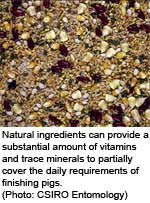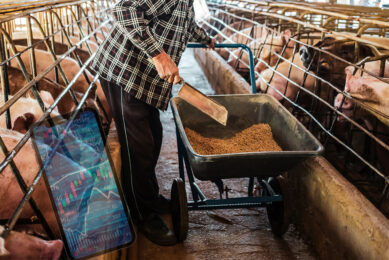Vitamins and trace minerals: Back to basics

When hog prices are low and feed costs are high, a strict re-evaluation of the essentiality and effectiveness of dietary additives and nutrient concentrations is warranted. Vitamins and trace minerals are a constant addition to any finishing pig diet and as such they deserve the widest examination.
Vitamins and trace minerals are naturally found in most feedstuffs in variable amounts. Nutritionists, how-ever, routinely supplement pig diets with these micro-nutrients via premixes in concentrations often in excess of established requirements. This is done for a good reason! Generous margins of safety have been traditionally employed because of variability in animal performance, genetics, health status, and environmental conditions found in commercial situations. In addition, the cost of vitamin and trace mineral supplementation has been historically low; about 5% of a complete pig diet.
A thorough study of the recent report of the National Research Council’s Subcommittee in Swine Nutrition (the only recent and scientifically established source of such information) reveals that there is a lack of meaningful research concerning the actual vitamin and trace mineral requirements of finishing pigs. Extrapolation of data from young pigs has been used extensively in establishing requirement estimates for older pigs; a method that raises questions about the validity of such figures. More research is therefore needed to fill this gap in our knowledge!
Ingredients and diets
Vitamins and trace minerals supplied via premixes usually meet or exceed requirement estimates, as amounts of these nutrients found in natural feed ingredients are usually neglected (Table 1).Unknown bioavailability, variable concentrations, destruction during storage and processing, and relatively low cost (until recently) of straight vitamins and trace minerals account for this nutritional practice. However, we already depend on natural feedstuffs to cover requirements for a number of water-soluble vitamins and semi-essential trace minerals that are not usually included in most premixes (these include biotin, folate, chromium, vanadium, boron, etc.)The most common trace minerals added to finishing diets are iron, zinc, copper, manganese, iodine, and selenium. Although several other trace and ultra trace minerals (e.g., chromium, cobalt, boron, vanadium) have an established physiological role, their dietary essentiality cannot be easily proven because they are required at extremely low amounts. Soybean meal and phosphates contain enough iron, copper, and manganese to more than cover animal requirements without further supplementation (Table 2) even in low phosphorus diets without phytase. The only concern in trace mineral supply is with iodine and selenium, especially in selenium-poor areas.As far as vitamins are concerned, maize and soybean meal are good sources of pyridoxine, thiamin, choline, folacin, and biotin for finishing pigs (Table 3). Other water-soluble vitamins, such as riboflavin, pantothenic acid, niacin, and vitamin B12, and all of the fat-soluble vitamins (A, D, E, and K) are routinely added to swine diets. Several vitamins, such as biotin, might need to be supplemented when alternate cereals, like wheat and biotin, and protein sources are used.
NRC requirement estimates
In the most recent publication of NRC (1998), requirement estimates for trace minerals have remained unchanged from the previous edition (NRC, 1988) because of lack of research in this area. The only exception was selenium, which was raised from 0.10 to 0.15 mg/kg. Data used in these estimates is not only outdated, as it has been generated with obsolete genetics and management practices, but also it is frequently extrapolated from experiments with young pigs where artificial conditions were employed to achieve adequate levels of deficiency.
Iron
The iron requirement estimate of 40 mg/kg for finishing pigs (80-120 kg body weight) is extrapolated from research with post weaning pigs, and from studies in which pigs were fed milk or casein-based diets. Actually, the NRC subcommittee stated that “natural feed ingredients usually supply enough iron to meet post weaning requirements”. Sources of iron include not only natural feedstuffs but also feed-grade phosphates(0.5 to 1% iron), dirt, dust, and even metallic equipment!
Zinc
For zinc, a sufficient number of studiesindicate that growing pigs require approx. 50 mg/kg of diet, in phytate-rich diets. However, these assays were associated with parakeratosis rather than growth performance per se. Nevertheless, a typical maize-soybean meal–based diet will supply about half of this requirement estimate.
Copper
The requirement for copper (3 mg/kg) is extrapolated again from research with neonatal pigs, which required about 5-6 mg/kg. There is no data concerning requirements during the growing-finishing period. Therefore, the NRC subcommittee stated that “the requirement for later stages of growth is probably no greater than 5-6 mg/kg”. With maize-soybean meal diets supplying more than 7 mg/kg copper, it is questionable whether copper supplementation is justifiable at all.
Manganese
The only relevant study concerning manganese requirement indicated that neonatal pigs require no more than 0.4 mg/kg manganese. Nevertheless, the NRC subcommittee recommends 4 and 2 mg/kg manganese for nursery (3-5 kg) and finishing pigs (80-120 kg), respectively. No explanation was given for such wide extrapolation. A typical maize-soybean meal diet will supply more than 14 mg/kg manganese, in addition to manganese found in feed-grade limestone (0.02%) and calcium phosphates (0.14%). Therefore, supplemental manganese is not essential for normal growth and bone formation in growing-finishing pigs.
Iodine
The requirement estimate for iodine is based on research in which 0.14 mg/kgwere needed to prevent thyroid hypertrophy in pigs fed maize-soybean meal-based diets. No titration assays are available concerning growth performance. Most natural ingredients contain essentially no iodine, with the exception of sea-derived ingredients. Iodine stores in thyroid, in the form of hormone T3, are thought to be enough to cover needs for at least 100 days.
Selenium
The selenium nutrition in pigs has received considerable attention. About 0.15 mg/kg selenium are required for optimal performance in finishing pigs. However, serum selenium and glutathione peroxidise activity plateau at only 0.1 mg/kg in reproducing gilts. Diets based on grains produced in soils poor in selenium are more likely to require supplementation. The requirement for supplemental selenium for growing-finishing pigs lies between 0.05 and 0.10% (a level that achieves a plateau response in glutathione peroxidase activity). No growth performance or carcass characteristic responses were observed in pigs offered diets supplemented with organic or inorganic selenium from 20-105 kg body weight. A typical maize-soybean meal diet contains about 0.12 mg/kg selenium.
Vitamin A
The vitamin A requirement for 80-120 kg
pigs is estimated to be 2,200 IU/kg. This figure, however, was based on liver storage and cerebrospinal fluid pressure criteria (1,000-2,700 IU/kg) and not on growth performance, which was maximised between 100 and 380 IU/kg. In fact, the subcommittee stated that “swine are able to store vitamin A in the liver, which makes the vitamin available during periods of low intake”.
Vitamin D
It is suggested that 200 IU/kg vitamin D for growing pigs is adequate for growth, but researchers have failed to observe any positive growth response to supplemental vitamin D. It takes 4-6 months for pigs fed a vitamin D-deficientdiet to develop signs of deficiency.
Vitamin E
The vitamin E requirement of growing pigs is well reviewed. Apart from growth, there are many other known factors that substantially affect vitaminE requirement. Pork meat quality is closely related with dietary levels of supplemental vitamin E and thus this vitamin might be needed for improving marketing characteristics of meat. Selenium deficiency increases requirements for vitamin E. In diets with adequate selenium, 10-15 IU/kg supplemental vitamin E did not affect health and performance. However, in selenium-deficient diets, 5 IU/kg vitamin E was not adequate to prevent deficiency lesions and mortality.
Vitamin K
Requirement estimates for vitamin K are based on anticoagulation tests with pigs reared in wire-bottomed cages that minimised coprophagy (a source of vitamin K), or with pigs that were administered with a blood coagulation agent, pivalyl. The subcommittee stated that “bacterial synthesis of vitamin K and subsequent absorption, directly or by coprophagy (eating own faeces), reduces or eliminates the need for supplemental vitamin K”. However, when antimicrobial agents are routinely used, microbial synthesis of vitamin K might become problematic. Aflatoxin contamination of grain crops also increases vitamin K requirements.
Niacin
The niacin requirement for finishing pigs (7 mg/kg) has been extrapolated from data with 10-50 kg pigs that were fed diets marginal in tryptophan. Tryptophan is a precursor of niacin. However, when dietary tryptophan concentration was above requirement, 45-kg pigs did not benefit from supplemental niacin. Niacin in maize is practically unavailable in young pigs.
Riboflavin
For riboflavin, no data exist concerning requirements for finishing pigs. Therefore,estimates were based on extrapolation from studies with young pigs. The riboflavin in maize-soybean meal-based diets is 59% bioavailable relative to crystalline riboflavin in chicks.
Pantothenic acid
Several reports indicate that the riboflavin requirement of pigs weighing 20-90 kg is 6-10.5 mg/kg of diet. The bioavailability of pantothenic acid in maize and soybean meal is higher than in barley, wheat, and sorghum.
Vitamin B12
The requirement for vitamin B12 for finishing pigs was derived from experiments with pigs weighing 10-45 kg (requirement ranged from 8.8-11.0 μg/kg) that were kept in cages with wire floors. The requirement for vitamin B12 can be satisfied by microbial synthesis in the hind gut and also by coprophagy. Most animal- and fermentation-derived ingredients contain vitamin B12, whereas plant materials are devoid of it. Because vitamin B12 storage in liver and enterohepatic circulation are extremely effective, depletion takes up to 5 years to produce signs of deficiency.
The requirements for biotin, choline, folate, pyridoxine, and thiamin (i.e., vitamins not usually supplied via premixes for finishing pigs) have also been established by extrapolation from studies with young pigs.
Body stores
Clearly, little thought has been given to body stores later in life as sources of micro-nutrients before slaughter. Furthermore, the role of microbial synthesis and intestinal absorption of vitamins of microbial origin has been underestimated. Similarly, the natural phenomenon of coprophagy invariably observed in pigs housed in slatted and solid floors has been overlooked as a source of nutrients. Although the relative low cost of micro-nutrient supplementation has historically justified routine supplementation of vitamins and trace minerals up to market age, modern advances in nutrition and reduced profit revenue mandate a re-evaluation of such practices. Nevertheless, it is now high time to re-evaluate traditional formulas containing standard industry premixes taking into account new data and experiences. It is indeed possible to have substantial savings by a correct reformulation of a premix recipe and a judicial use of this premix, especially during the last phase of production where margins are usually being made or lost.
Source: AllAboutFeed Vol 1 no 4, 2010











